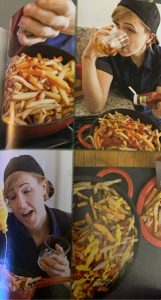Background:
My Drunk Kitchen is a book written by Hannah Hart, a popular Youtuber. Prior to her career as an author and Youtuber, she earned degrees in English literature, and the Japanese language from the University of California, Berkeley (Wikipedia). Hart initially began posting cooking videos online as a hobby before publishing her cookbook. She published the cookbook on August 12th, 2014, during a time that was huge for social media. Hart’s popularity online definitely helped to market her cookbook to an audience that might not typically be very interested in the topic. She received no formal culinary training prior to posting her cooking videos online, and many of her recipes are both fun and easy to make (Wikipedia). What she lacks in training she makes up for in personality, and provides readers with a fun reading experience.

Audience:
The simple recipes throughout the book show that this book was written with young people, and people who like to drink in mind. Hart has been able to make all these recipes on her channel while she is drunk, so they must be fairly easy. Also, many of the recipes require very few utensils to make and can be made with easily accessible ingredients. Hart has written this book in a way that makes it enjoyable to read, with fun facts, and side notes included on nearly every page. This shows that she wants to create a pleasurable reading experience, and markets this book outside of those who would normally purchase a cookbook. Lastly, this book is definitely not marketed towards health conscious people. Many of the recipes are fairly unhealthy, because they prioritize convenience over choosing whole ingredients. This is evident when Hart states “I genuinely don’t believe in dieting.” on page 88. Hart’s audience is people who would not normally
purchase a cookbook, and she targets that niche well by creating a non traditional cookbook.
Identity:
This book has many examples of Hart’s personal identity dispersed throughout it because of the way it is written. First, the book has an extremely open approach towards gender as Hart is homosexual herself. She states “Hey girl. Or guy. Or whatever gender pronoun floats your boat” (page 121). This cookbook is also very heavily influenced by Hart’s American culture. Hart has several Thanksgiving recipes, an American invented tradition, and she also places a

lot of importance on convenience, which is huge in American culture. Also, Hart’s inventive identity shines through often, as many of the unconventional recipes are definitely Hart originals. The way Hart is able to spin her individual identity into the book makes it an experience unlike most other cookbooks.
Traditionalism:
On page 56 of the book Hart provides the recipe for “Frito Taquitos” and proceeds to explain them as “basically a soft tortilla that is layered with ingredients and then rolled.” This is a traditional taquito and Hart describes how to make it very easily. Traditionalism comes in a few pages later when Hart makes “Jewish Taquitos” by simply adding cream cheese. She calls the version with cream cheese “Jewish” because of the affiliation of the Jewish population with bagels. Changing a recipe by adding an ingredient commonly used by a particular group, adding the cream cheese, is an example of Hart traditionalizing a recipe. Another example is Hart’s “Pizzaddilla” on page 95. Hart has taken a traditional Mexican dish, a quesadilla, and changed the ingredients with those of another food that she also likes. By adding in the marinara sauce Hart totally changes the taste of the dish, and normalizes it more towards American culture. Lastly, another great example of traditionalism is the “crunchy roll” on page 71. This sushi inspired dish doesn’t contain any raw fish, and instead contains ingredients commonly found in American homes. Hart adapts many traditional dishes to easier, Americanized versions.
Cultural Tourism:
The book uses cultural tourism to appeal to a wider variety of people by making recipes inspired by many different countries. For example, the taquitos, and huevo ranchero, are traditional Mexican dishes, which Hart has adapted. Additionally, the engagement curry is a spin on the Indian dish, which Hart has simply told the reader to purchase a box of pre-made. Lastly, and possibly the best example of cultural tourism however comes on page 165 where Hart makes “Sad Thai.” However, Hart doesn’t actually cook anything for this recipe, and instead refers the reader to order from the “Thai food place down the street.” which would give the reader a pretty authentic Thai experience.

Identity Work:
Throughout the entirety of the book Hart chooses easy to make recipes, and accessible ingredients. This shows that she is a regular person just like the readers. Also, Hart dresses in regular clothes, rather than a chef’s outfit in the pictures. This also shows that she doesn’t see herself as any better cook than the readers. Lastly, Hart’s use of a regular kitchen, rather than an industrial one cements her as a people’s chef, and not an elitist.
Works Cited
En.wikipedia.org. 2021. Hannah Hart – Wikipedia. [online] Available at: <https://en.wikipedia.org/wiki/Hannah_Hart> [Accessed 27 April 2021].
Hart, H., 2014. My drunk kitchen. Dey Street Books.